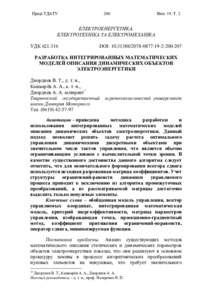Будь ласка, використовуйте цей ідентифікатор, щоб цитувати або посилатися на цей матеріал:
http://elar.tsatu.edu.ua/handle/123456789/7056| Назва: | Разработка интегрированных математических моделей описания динамических объектов электроэнергетики |
| Інші назви: | Розробка інтегрованих математичних моделей опису динамічних об'єктів електроенергетики Development of the integrated mathematical models for the description of the dynamic electric power plants |
| Автори: | Диордиев, Владимир Трифонович Діордієв, Володимир Трифонович Diordiiev, Volodymyr Кашкарев, Антон Александрович Кашкарьов, Антон Олександрович Kashkarov, Anton Диордиев, А. А. |
| Ключові слова: | обобщенная модель управления;вектор управляемых координат;интегрированная математическая модель;критерий энергоэффективности;матрица параметров управления;изображающая точка;проекционно-градиентный метод;коэффициент притяжения ограничений-неравенств;оператор сдвига;минимизируемая функция |
| Дата публікації: | 2019 |
| Серія/номер: | Праці ТДАТУ;Вип. 19, т. 2 (С. 200-206) |
| Короткий огляд (реферат): | RU: Приведена методика разработки и использования интегрированных математических моделей описания динамических объектов электроэнергетики. Данный подход позволяет решить задачу расчета оптимального управления динамическими дискретными объектами при значительном числе тактов управления, что является обычно ограничивающим условием с вычислительной точки зрения. В качестве существенного достоинства данного алгоритма следует отметить, что для окончательного формирования вектора сдвига используется исходная разреженная матрица коэффициентов. Учет структуры ограничений-равенств динамики управляемого процесса приводит к исключению из алгоритма промежуточных преобразований, а из рассматриваемой матрицы достаточно выделить только ненулевые элементы. UK: Наведено методику розробки і використання інтегрованих математичних моделей опису динамічних об'єктів електроенергетики. Даний підхід дозволяє вирішити задачу розрахунку оптимального управління динамічними дискретними об'єктами при значному числі тактів управління, що зазвичай обмежують умовою з обчислювальної точки зору. У якості істотної переваги даного алгоритму слід відмітити, що для остаточного формування вектора зсуву використовується вихідна розріджена матриця коефіцієнтів. Облік структури обмежень-рівностей динаміки керованого процесу призводить до виключення з алгоритму проміжних перетворень, а з матриці, яка розглядається, достатньо виокремити тільки не нульові елементи. EN: The methodology of the development and use of integrated mathematical models for describing dynamic objects of electric power industry is given. This approach allows us to solve the problem of the optimal control calculating for the dynamic discrete objects with a significant number of control cycles, which usually is a limiting condition from a computational point of view. As a significant advantage of this algorithm, it should be noted that the original sparse matrix of coefficients is used for the final formation of the shift vector. I.e. the procedure of replacing zero elements with non-zero ones in the process of algorithmic transformations as a characteristic of well-known optimization methods is not used and the number of iterations is significantly reduced during the obtaining of a solution using the algorithm of the projection-gradient optimization method. This, in turn, simplifies the algorithmic and software optimal tasks for the operational management of dynamic objects. Moreover, it is assumed for further analysis, that the dimension of the vector of control actions is equal to the dimension of the vector of adjustable values. Bilateral restrictions are imposed on these values with the task is to find such a sequence of control actions that delivers at least some criterion of the system quality, for example for the integral criterion of energy efficiency. Additionally, the shift vector differences for the adopted non-Euclidean and Euclidean metrics are the coefficients of attraction of the inequality constraints, equal to the difference of Lagrange multipliers of the constraints corresponding to the lower and upper limits of the allowable change of variables. The possibility of such a simple calculation of these quantities is a fundamental feature of the method under consideration. This makes it possible effectively take into account the activity of inequality constraints when moving to an extremum of an optimized function. The considering the structure of equality constraints of the controlled process dynamics leads to the exclusion of intermediate transformations from the algorithm, and from the matrix under consideration it is enough to select only nonzero elements. So, for this case the required coefficient matrix is represented as functionally and structurally identical units of dimensions and its number should be equal to the number of control cycles, where each block contains two matrices. |
| URI (Уніфікований ідентифікатор ресурсу): | http://elar.tsatu.edu.ua/handle/123456789/7056 |
| Розташовується у зібраннях: | кафедра Електроенергетика і автоматизація |
Файли цього матеріалу:
| Файл | Опис | Розмір | Формат | |
|---|---|---|---|---|
| Праці ТДАТУ 2019 Том 2-201-208.pdf | 539.65 kB | Adobe PDF |  Переглянути/Відкрити |
Показати повний опис матеріалу
CORE Recommender
Перевірити
Усі матеріали в архіві електронних ресурсів захищені авторським правом, всі права збережені.
